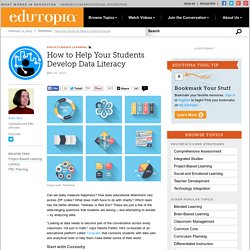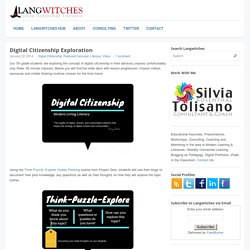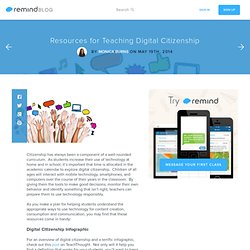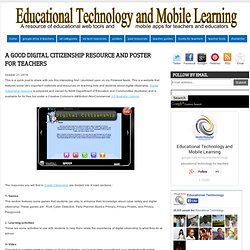

Digcit_contractedmodo_100112_8.5x11.pdf. Digiteacher - Let's Talk about Digital Citizenship. Digital citizenship encompasses many aspects of life, not always limited to the work done on or with a 'computer'.

It can be described as knowing how to behave reliably, responsibly and respectfully with regard to technology use. Video: Learning to Change and Changing to Learn (Student voices) To help students and teachers understand digital citizenship, we’ve developed a model called Enlightened Digital Citizenship. First, every digital citizen must have access to technology before they can even become a digital citizen. Then, as they approach situations, they should frame their analysis in five areas of awareness: technology, individual, social, cultural, and global. Enlightened Digital Citizenship - The awareness and competencies of the effective digital citizen Technology Access Before a person can become part of the digital society he or she must have access.
How to Help Your Students Develop Data Literacy. Can we really measure happiness?

How does educational attainment vary across ZIP codes? What does math have to do with charity? Which team has the better athletes, Yankees or Red Sox? These are just a few of the wide-ranging questions that students are asking -- and attempting to answer -- by analyzing data. "Looking at data needs to become part of the conversation across every classroom, not just in math," says Harshil Parikh. Start with Curiosity The idea for TuVaLabs emerged when Parikh was tutoring children in the slums of Delhi, India. But curiosity alone isn't enough to ensure that learning happens. "We want to be a bridge between schools and the open data movement," Parikh explains.
Leverage Tools and Techniques What does data analysis look like in a K-12 classroom? The Global Happiness Project, designed by the New Tech Network, offers an engaging example. Connect Data to Student Interests Start Early Thinking analytically about data can start as early as the elementary grades. Digital Citizenship Exploration. Our 7th grade students are exploring the concept of digital citizenship in their advisory classes (unfortunately only three- 30 minute classes).

Below you will find the slide deck with lesson progression, chosen videos, resources and visible thinking routines chosen for the time frame Using the Think-Puzzle- Explore Visible Thinking routine from Project Zero, students will use their blogs to document their prior knowledge, any questions as well as their thoughts on how they will explore the topic further. After class writes and reads each other’s blog posts, spark a discussion about the following terms. Did they come up in students’ blog posts? What other ones were mentioned? As a class watch the following videos dealing with cyberbullying, online/offline identity, sharing and digital footprint. Allow students time to explore further resources (searching on their own) or get started with the following sites.
Discuss the following infographic by Mia MacMeekin . Related Is it personality? Resources for Teaching Digital Citizenship. Citizenship has always been a component of a well-rounded curriculum.

As students increase their use of technology at home and in school, it’s important that time is allocated in the academic calendar to explore digital citizenship. Children of all ages will interact with mobile technology, smartphones, and computers over the course of their years in the classroom. By giving them the tools to make good decisions, monitor their own behavior and identify something that isn’t right, teachers can prepare them to use technology responsibly. As you make a plan for helping students understand the appropriate ways to use technology for content creation, consumption and communication, you may find that these resources come in handy: Film-festival-digital-citizenship?crlt_pid=camp. "Digital citizenship" is an umbrella term that covers a whole host of important issues.

Broadly, it's the guidelines for responsible, appropriate behavior when one is using technology. But specifically, it can cover anything from "netiquette" to cyberbullying; technology access and the digital divide; online safety and privacy; copyright, plagiarism, and digital law, and more. In fact, some programs that teach digital citizenship have outlined no less than nine elements that intersect to inform a well-equipped digital citizen. It's an overwhelming array of skills to be taught and topics to explore. But while there is much talk about the importance of teaching digital citizenship in this information society, not many are sure what that really looks like. Video Playlist: Teaching Digital Citizenship Watch the player below to see the whole playlist, or view it on YouTube. Netiquette Online Discussion Boards infographic. A Good Digital Citizenship Resource and Poster for Teachers. October 21, 2014 This is a quick post to share with you this interesting find I stumbled upon on my Pinterest feeds.

This is a website that features some very important materials and resources on teaching kids and students about digital citizenship. Digital Citizenship resource is prepared and owned by NSW Department of Education and Communities (Australia) and is available for for free but under a Creative Commons Attribution-NonCommercial 3.0 Australia Licence. The resources you will find in Digital Citizenship are divided into 4 main sections :